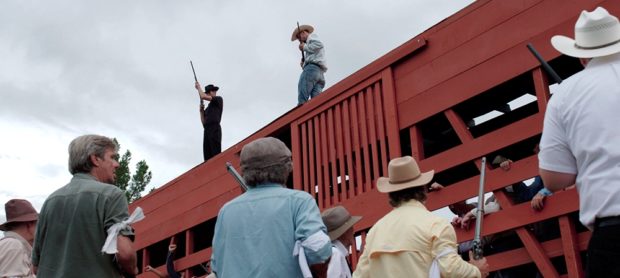 Robert Greene documents the centenary reenactment of the Bisbee deportation, the infamous rounding up and expulsion of striking copper miners in Bisbee, Arizona, in 1917.
Robert Greene documents the centenary reenactment of the Bisbee deportation, the infamous rounding up and expulsion of striking copper miners in Bisbee, Arizona, in 1917.
In 1917, a tragic and criminal episode in American history occurred in the copper mining town of Bisbee, Arizona. Local miners had recently been organized by the IWW, International Workers of the World, and a strike was called in late June, to protest low wages, discrimination, and poor safety conditions. The U.S. had declared war against Germany three months before, and the mining companies used that as a justification for putting down the strikers, saying that such a strike, which would hurt arms production, was anti-American and pro-German. The County Sheriff met with Phelps Dodge officials to put together a list of striking miners. Then on July 12, 1917, a large sheriff’s posse went around Bisbee rounding up about 2000 men at gunpoint. They were taken to the local baseball field, with machine guns placed at strategic points. Non-IWW members were told they would be freed if they renounced the strike. About 700 men took that offer. The other approximately 1300 men, mostly Mexican and eastern European immigrants, were marched to the railroad yard, put in cattle cars, and then taken on a 16-hour trip to the New Mexico desert, a few miles from the border at Columbus, where they were dropped off without food or water and told never to return to Bisbee.
Such are the facts reported in the opening title sequence of Bisbee ’17, a documentary by Robert Greene. In his previous documentaries, Robert Greene has demonstrated a fascination with the psychological aspects of reenacting actual events. In 2017, last year, he got to enlist the people of this small town in his ongoing project, as the centenary of the Bisbee deportations approached. Bisbee ’17 shows the preparations for, and the July 12 reenactment of the events occurring exactly 100 years earlier.
In the film, we gradually get introduced to some of the main reenactors. A woman tells the story of her grandfather and his brother, her great-uncle. The grandfather was one of the sheriff deputies on that day, and he went to his own brother’s house and took him away at gunpoint. She justifies this as the right thing to do, given the wartime emergency. Another older Bisbee resident, who started as a miner and eventually became a company boss, tells of his grandfather’s participation in the round-up. He defends the deportation as being necessary in order to prevent a bloodbath by what he characterizes as dangerous radicals. He takes the role in the film of Walter S. Douglas, the president of Phelps Dodge. These pro-company residents appear to be a minority. Many others are pro-union, and some say that both sides had to do what they thought best. You have to remember, watching this, that the older families of Bisbee are descended from the winners in this struggle.
The film shows us how the participants go through some emotional turmoil throughout this process, and the actual reenactment becomes painful and cathartic. Greene focuses especially on one young Mexican-American resident, Fernando Serrano, whose lanky build and haunting face makes him a perfect photographic subject. Serrano, who experienced a political awakening during filming, wanders throughout the scenes as a symbol of working class suffering and resistance. Greene uses the local theater, one of the bars in Brewery Gulch, and the baseball field itself, among other places, as representing the intersection of memory and present day awareness.
The picture is shot in a widescreen Cinemascope ratio, and that, plus having visited Bisbee many times myself and now seeing familiar streets and buildings on the big screen, made Bisbee ’17 a stirring experience. Beyond that, the film transcends the usual historical documentary form to become a profound meditation on how we deal with tragic and unjust events like the Bisbee deportation, events we’d rather not think about, but are forced to confront.

A dark comedy that stretches across the 20th century in Yugoslavia, Underground is a film of excess that laughs derisively at the colossal waste...

Guillermo del Toro adds his own Gothic sensibility to this thrilling new version of an old film noir. After winning the Best Picture Oscar...

Every year I make a list, like most film critics, of my favorite movies from the previous year. I do mine later than just...